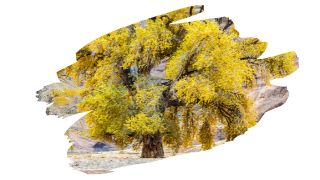When it comes to wood carving, not all wood types are created equal. You see, different wood types have different densities — making some of them more suited for whittling than others.
Moreover, some wood types have a high tendency to crack and split. And other’s have a grain texture that’ll struggle to hold any kind of intricate design.
So, how does Cottonwood in particular really measure up as a carving wood?
Well, in this post, you will learn why not all wood types suit all styles of carving. You will also discover which woodcarving style that Cottonwood’s best paired with.

This post may contain affiliate links to products that we receive a commission for (at no additional cost to you). Learn more here.
What’s The Best Type Of Wood For Carving?
The best type of carving wood is pretty much the one that’s ideally suited for your carving style.
You see, carving styles that require light delicate cuts — typically using manual hand tools — need fairly low density woods. While carving styles that use power tools, need a wood that’s tough, hard and dense.
Related Post: 9 Easy Whittling Projects For Beginners (That You Can Make This Weekend)
So, What Type Of Wood Does My Carving Style Need?
If you are want to do some whittling with a whittling knife, then you are going to need a pliable wood. Also, that wood needs to be able to hold your designs well too.
So, for whittling, Basswood and White Pine are great choices. These wood types are amongst the softest wood species around.
For styles that require more forceful carving, (like Chip Carving), your wood needs to come from a harder lumber. So, wood types like Black Walnut and Cherry wood are perfect.
However, when it comes to power tool carving styles, you need to use reasonably tough timber. So, styles like chainsaw carving, and even wood turning, are best paired with European Oak (also known as White Oak).
Related Post: Is Oak Wood A Good Choice For Chainsaw Carving?
OK…So What About Cottonwood? What Type Of Carving Style Is This Wood Type Suited For?
Well, one of the first things you need to check about Cottonwood, is exactly how hard it is. And one way to measure the hardness of a wood is by checking where it lies on the Janka scale.
All wood species will have a Janka rating that falls somewhere along the Janka hardness scale.
And What Is The Janka Rating Exactly?
The Janka rating measures the force it takes for a piece of metal to dent a piece of wood. The more force it takes, the higher the Janka rating. And the higher the Janka rating, the harder and tougher the wood.
For example, let’s take a quick look at Basswood’s Janka rating. This very soft timber has a Janka rating of 410 lbf. What this means is that it takes a mere 410 pounds of force to make a dent in this timber.
Now, when we compare it against Basswood, Cottonwood is just a touch tougher. Eastern Cottonwood, (which is a Cottonwood tree species that grows right around North America), has a Janka rating of just 430 lbf.
Related Post: 11 Surprisingly Simple Wood Carving Projects for Absolute Beginners
So, Does That Mean Cottonwood Is Very Easy To Carve?
You can easily cut into Cottonwood with a manual whittling tool. But, full disclosure, this lumber is a tricky wood to carve.
Why? Well, because the texture of Cottonwood’s interlocking grain is kind of stringy.
On top of that, it’s grain has a tendency to separate — particularly if you are working on green Cottonwood. So, that makes it doubly difficult to get this lumber to hold your designs.
Now, it’s worth restating that it is still very easy to carve into this pliable wood. So, it probably has some worth as a practice whittling wood — but not for much more than that.
However, while all of this might be true about Cottonwood lumber, the same cannot be said for Cottonwood tree bark.
What’s Interlocking Grain? Interlocking grain refers to the directional growth of tree rings. A tree with interlocking grain has tree rings that’ll spiral, in alternating directions, every few years or so.
And What’s So Special About Cottonwood Tree Bark?
Well, Cottonwood tree bark is very thick — anywhere from 4 inches to 8 inches thick (depending on your supplier). Either way, this tree’s bark is thick and hard enough to be worth carving in and of itself.
That’s because Cottonwood tree bark has a more consistent texture to it than that Cottonwood timber. And that consistency means that the bark is much easier to carve.
But, fair warning, Cottonwood tree bark is fairly brittle. So, as you carve it, don’t be surprised if small chunks of the outermost tree bark simply splinter right off.
To Wrap Up, Here Are The 3 Key Takeaways From This Post…
- 1). Cottonwood is one of the most soft hardwood trees.
- 2). But, the timber of this tree is difficult to cut cleanly, thanks to its stringy texture.
- 3). However, the texture of Cottonwood tree bark is more consistent. Which is why Cottonwood tree bark is better for carving with.



